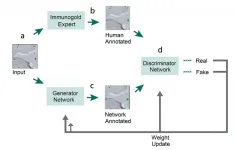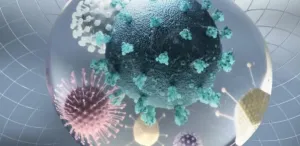Gold digger: Neural networks at the nexus of data science and electron microscopy
Researchers at the Max Planck Florida Institute for Neuroscience used machine learning to develop a new, fully automated way to search and identify gold particles markers in electron micrographs with near human-level accuracy
2021-04-20
(Press-News.org) From sample preparation to image acquisition, electron microscopy (EM) requires precise and time-consuming steps to produce the clarity and detail needed to visualize small cell structures with high resolution. Moreover, once EM images are created, extracting the biological information out of them through analysis can be an even more laborious and time intensive task. Especially because current EM analysis software often requires the skilled eye of a scientist to manually review hundreds of images.
With a bit of ingenuity and the application of cutting-edge neural networks, an interdisciplinary team of scientists at the Max Planck Florida Institute for Neuroscience (MPFI) have created a new powerful analysis software aimed at streamlining part of the lengthy process. In collaboration with the Electron Microscopy Core Facility and the Christie Lab, the project tasked two high school students with dramatically improving upon established computer-based techniques for the analysis of protein distribution in EM images. Unlike traditional light microscopy that uses fluorescent labeling, EM requires proteins to be labeled with gold nanoparticles in order to visualize them within a cell. Playfully named "Gold Digger", the software uses a deep learning approach to identify gold particles bound to specific proteins of interest.
In their new publication in Scientific Reports, the MPFI team has engineered an adaptable, deep learning-based algorithm capable of accurately identifying different sizes of gold particles. This fully automated approach will speed up the counting process and generate more precise location information of protein distributions across a membrane, expediting new breakthroughs.
Deep learning or neural networks is a computational strategy that allows software to progressively learn over time. Much like the human brain, these types of algorithms are able to deconstruct a visual scene into individual components and be taught to recognize certain aspects. By supplying pre-annotated "training data" the software learns how to copy and mimic human actions for a given task, something that computers weren't able to do in the not-so-distant past.
"One of the challenges of the project, was figuring out a way to train our software to recognize only gold particles which appear dark on an electron micrograph, as opposed similarly looking shadows caused by the uneven surface of a cell; something that only trained EM experts could do previously" explains Dr. Michael Smirnov, Neural Data Scientist at MPFI and corresponding author of the publication. "We found that by feeding enough training data and correcting errors that pop up in our algorithms, our software could distinguish gold particles from these shadow artifacts with near human level accuracy. I think this really demonstrates the robustness and utility of our technique."
This project started with the curiosity of two high school data science students, Diego Jerez and Eleanor Stuart, but quickly it developed into a more complex and interdisciplinary project. "I feel very lucky to get the unique opportunity to apply what we've learned in the classroom setting to real world scientific pursuit, and seeing first-hand how data science can help address scientific questions," explained Diego Jerez, first author of this publication. "These young students showed a real aptitude for this type of coding and conceptual work and I couldn't be more proud of what they have accomplished. I can't wait to see the contributions they'll make to the scientific community in the future," describes Dr. Smirnov.
The small, compact architecture of the Gold Digger software was primarily used for freeze fracture replica EM, but it was specifically designed to be generalizable and compatible between various EM applications including changes in magnification, image area, cell type and gold particle size. The software will soon be distributed open source and include a user-friendly interface. Scientists everywhere will have the opportunity to take full advantage of and improve upon this innovative algorithm.
"The synergy of the collaborative work of our team was crucial to bridge the gap between these areas of expertise" explained Naomi Kamasawa, Ph.D., the Head of the Electron Microscopy Core Facility at MPFI. "But this is what the Max Planck Society does - bring together people who are passionately curious about a variety of subjects, and allow them to be creative together. When you do that, anything is possible."
INFORMATION:
[Attachments] See images for this press release:

ELSE PRESS RELEASES FROM THIS DATE:
2021-04-20
OAK BROOK, Ill. - People living with human immunodeficiency virus (HIV) and without known cardiovascular disease have two to three times the noncalcified coronary plaque burden of non-HIV healthy volunteers, according to a study from Canada published in Radiology. Researchers said the results underscore the importance of a heart-healthy lifestyle in people living with HIV.
HIV/AIDS emerged as a major public health crisis in the 1980s. Disease-related mortality peaked in the mid-1990s and has been dropping since, thanks in large part to antiretroviral therapy, which does not cure the disease but helps control it.
Today, people ...
2021-04-20
Researchers at Beam Therapeutics have developed a redesigned base editor that shows considerable promise in directly repairing the single-base mutation that causes sickle-cell disease (SCD). Many strategies are being pursued to harness genome editing approaches including CRISPR to treat patients with SCD and related hemoglobinopathies. The most advanced method in the clinic involves targeting an upstream regulatory pathway to switch on expression of the fetal hemoglobin gene but does not target the SCD mutation directly.
Writing in the April issue of The CRISPR Journal, a team at Beam Therapeutics, led by Ian Slaymaker and Giuseppe Ciaramella, describe the successful ...
2021-04-20
In a study conducted at the University of Helsinki, researchers found a cause for severe epilepsy resulting in death in Parson Russell Terrier puppies at a few months of age. A change in the PITRM1 gene can lead to a dysfunction of mitochondria, the cellular energy pumps. Concurrently, amyloid-β accumulation and widespread neurodegeneration associated with Alzheimer's disease were identified in the puppies' brains. Changes to the PITRM1 gene in humans also cause a severe but slowly progressing brain disease.
Some Parson Russell Terrier puppies were seen to suddenly develop epileptic seizures at 6 to 12 weeks of age. The disease progressed very rapidly, in a matter of hours in the worst cases, to a situation where the seizures were continuous and unresponsive to medication.
"All ...
2021-04-20
Exposure to certain endocrine-disrupting chemicals could elevate the risk of breast cancer, according to a new comprehensive systematic review of epidemiological research. However, for many chemicals, evidence is inconsistent or still limited. The review was carried out by researchers at the universities of Hong Kong and Eastern Finland and published in Critical Reviews in Food Science and Nutrition.
Endocrine-disrupting chemicals (EDCs) can interfere with the body's hormonal system, also called the endocrine system, and are widely present in the environment. They originate from a variety of ...
2021-04-20
If the CO2 content of the atmosphere is not to increase any further, carbon dioxide must be converted into something else. However, as CO2 is a very stable molecule, this can only be done with the help of special catalysts. The main problem with such catalysts has so far been their lack of stability: after a certain time, many materials lose their catalytic properties.
At TU Wien, research is being conducted on a special class of minerals - the perovskites, which have so far been used for solar cells, as anode materials or electronic components rather than for their catalytic properties. Now scientists at TU Wien have succeeded in producing a special perovskite that is excellently suited as ...
2021-04-20
As we accumulate more and more gene-sequencing information, cell-type databases are growing in both size and complexity. There is a need to understand where different types of cells are located in the body, and to map their gene expression patterns into specific locations in tissues and organs. For example, a gene can be actively expressed in one cell while suppressed in another.
One way of mapping genes into tissues is a technique called in situ hybridization. Simply put, a target gene is tagged ("hybridized") with a fluorescent marker within the sections of the tissue it is located in (the "in situ" part). The sections are then visualized under a specialized microscope to see where the gene "lights up". Consecutive photographs of each section are then put together to generate a ...
2021-04-20
Lafora disease is an inherited neurodegenerative condition that initially develops with seizures in adolescence and evolves with progressive degeneration of the nervous system to death, about ten years after its onset. It is characterised by the accumulation of abnormal glycogen aggregates called Lafora bodies in the brain. There is currently no treatment for this condition, although some therapies are being tested in clinical trials.
Led by Dr. Joan Guinovart, emeritus professor of the University of Barcelona (UB) and also group leader of CIBERDEM, the Metabolic Engineering lab at IRB Barcelona has discovered that Lafora bodies that accumulate in glial cells, which are essential for the proper ...
2021-04-20
You can lubricate a bicycle chain with oil, but what do you do with a Mars rover or a red-hot conveyor belt in the steel industry? Very special nanomaterials have now been studied by the TU Wien together with research groups from Saarbrücken (Germany), Purdue University in the USA and the Universidad de Chile (Santiago, Chile).
The material class of MXenes (pronounced "maxene") has caused quite a stir in recent years in connection with novel battery technologies. But it now turns out that they are also an excellent solid lubricant that is extremely durable and performs its task even under the most difficult conditions. These remarkable properties of MXenes have now been published in the renowned journal ACS Nano.
Like a stack of sheets of paper
Just ...
2021-04-20
A new type of COVID-19 testing strategy could help streamline the process of identifying cases, tracking variants and detecting co-infecting viruses.
At present, separate assays and complex workflows are involved in each of these three diagnostic procedures, with analyses typically performed in highly specialized facilities. KAUST researchers have now combined all three kinds of tests into a single procedure that should allow for point-of-care tracking of COVID-19 and the many emerging variants of SARS-CoV-2.
"Our all-in-one test provides a promising integrated solution for rapid field-deployable detection and mutational surveillance of pandemic viruses," says stem cell biologist Mo Li, who led the study.
The test involves a portable ...
2021-04-20
Scrobiculariaplana is a type of wedge clam widely found along the coasts and estuariesof northern Europe, the Mediterranean and West Africa. Like other mollusks, it is used as a bioindicator to study pollution in these types of ecosystems, for its ability to accumulate heavy metals and organic pollutants.
A new study has managed to identify the transcriptome and the associated proteome of this bivalve, a finding that could represent an important leap forward in the early detection of pollutants in coastal areas. While the genome is the DNA content comprising the genetic information essential for life, the transcriptome includes only the information on genes that are expressed, while the proteome is the totality of proteins expressed at a given time and under specific conditions. Therefore, ...
LAST 30 PRESS RELEASES:
[Press-News.org] Gold digger: Neural networks at the nexus of data science and electron microscopy
Researchers at the Max Planck Florida Institute for Neuroscience used machine learning to develop a new, fully automated way to search and identify gold particles markers in electron micrographs with near human-level accuracy






